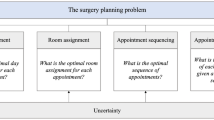Abstract
This paper presents a combination of optimization and data mining techniques to address the surgery scheduling problem. In this approach, we first develop a model to predict the duration of the surgeries using a data mining algorithm. The prediction model outcomes are then used by a mathematical optimization model to schedule surgeries in an optimal way. In this paper, we present the results of using three different data mining algorithms to predict the duration of surgeries and compare them with the estimates made by surgeons. The results obtained by the data mining models show an improvement in estimation accuracy of 36%. We also compare the schedules generated by the optimization model based on the estimates made by the prediction models against reality. Our approach enables an increase in the number of surgeries performed in the operating theater, thus allowing a reduction on the average waiting time for surgery and a reduction in the overtime and undertime per surgery performed. These results indicate that the proposed approach can help the hospital improve significantly the efficiency of resource usage and increase the service levels.
Access this chapter
Tax calculation will be finalised at checkout
Purchases are for personal use only
Preview
Unable to display preview. Download preview PDF.
Similar content being viewed by others
References
Cardoen, B., Demeulemeester, E., Beliën, J.: Operating room planning and scheduling: A literature review. European Journal of Operational Research 201(3), 921–932 (2010)
Bjornberg, A., Garrofe, B.C., Lindblad, S.: Euro health consumer index. Technical report, Health Consumer Power House (2009)
Siciliani, L., Hurs, J.: Explaining waiting-time variations for elective surgery across OECD countries. Economic Studies, vol. (38). OECD (2004)
Chang, J.K., Calligaro, K.D., Lombardi, J.P., Dougherty, M.J.: Factors that predict prolonged length of stay after aortic surgery. Journal of Vascular Surgery 38(12), 335–339 (2003)
Lazar, H.L., Fitzgerald, C., Gross, S., Heeren, T., Aldea, G.S., Shemin, R.J.: Determinants of length of stay after coronary artery bypass graft surgery. Circulation 92(9), 20–24 (1995)
Tu, J., Mazer, C.: Can clinicians predict ICU length of stay following cardiac surgery? Canadian Journal of Anesthesia 43(8), 789–794 (1996)
Macario, A.: Truth in scheduling: Is it possible to accurately predict how long a surgical case will last? Anesthesia & Analgesia 108(3), 681–685 (2009)
Guerriero, F., Guido, R.: Operational research in the management of the operating theatre: a survey. Health Care Management Science 14(1), 89–114 (2011)
Dexter, F., Traub, R.D., Qian, F.: Comparison of statistical methods to predict the time to complete a series of surgical cases. Journal of Clinical Monitoring and Computing 15(1), 45–51 (1999)
Li, Y., Zhang, S., Baugh, R.F., Huang, J.Z.: Predicting surgical case durations using ill-conditioned CPT code matrix. IIE Transactions 42(2), 121–135 (2009)
Strum, D.P., May, J.H., Vargas, L.G.: Modeling the uncertainty of surgical procedure times: comparison of log-normal and normal models. Anesthesiology 92(4), 1160–1167 (2000)
Combes, C., Meskens, N., Rivat, C., Vandamme, J.P.: Using a KDD process to forecast the duration of surgery. International Journal of Production Economics 112(1), 279–293 (2008)
Eijkemans, M.J.C., van Houdenhoven, M., Nguyen, T., Boersma, E., Steyerberg, E.W., Kazemier, G.: Predicting the unpredictable: A new prediction model for operating room times using individual characteristics and the surgeon’s estimate. Anesthesiology 112(1), 41–49 (2010)
Stepaniak, P.S., Heij, C., Mannaerts, G.H.H., Quelerij, M.D., Vries, G.D.: Modeling procedure and surgical times for current procedural terminology-anesthesia-surgeon combinations and evaluation in terms of case-duration prediction and operating room efficiency: a multicenter study. Anesthesia & Analgesia 109(4), 1232–1245 (2009)
Dexter, F., Epstein, R.H., Lee, J.D., Ledolter, J.: Automatic updating of times remaining in surgical cases using bayesian analysis of historical case duration data and instant messaging updates from anesthesia providers. Anesthesia & Analgesia 108(3), 929–940 (2009)
Alvarez, R., Bowry, R., Carter, M.: Prediction of the time to complete a series of surgical cases to avoid cardiac operating room overutilization. Canadian Journal of Anesthesia 57(11), 973–979 (2010)
Spangler, W., Strum, D., Vargas, L., May, J.: Estimating procedure times for surgeries by determining location parameters for the lognormal model. Health Care Management Science 7(2), 97–104 (2004)
Strum, D.P., May, J.H., Vargas, L.G.: Modeling the uncertainty of surgical procedure times: comparison of log-normal and normal models. Anesthesiology 92(4), 1160–1167 (2000)
Wright, I.H., Kooperberg, C., Bonar, B.A., Bashein, G.: Statistical modeling to predict elective surgery time. comparison with a computer scheduling system and surgeon-provided estimates. Anesthesiology 85(6), 1235–1245 (1996)
Stepaniak, P.S., Heij, C., De Vries, G.: Modeling and prediction of surgical procedure times. Statistica Neerlandica 64(1), 1–18 (2010)
Holmes, G., Hall, M., Frank, E.: Generating Rule Sets from Model Trees. In: Foo, N.Y. (ed.) AI 1999. LNCS, vol. 1747, pp. 1–12. Springer, Heidelberg (1999)
Breiman, L.: Bagging predictors. Machine Learning 24(2), 123–140 (1996)
Khuri, S., Bäck, T., Heitkötter, J.: The zero/one multiple knapsack problem and genetic algorithms. In: Proceedings of the 1994 ACM Symposium on Applied Computing, SAC 1994, pp. 188–193. ACM (1994)
Author information
Authors and Affiliations
Editor information
Editors and Affiliations
Rights and permissions
Copyright information
© 2012 Springer-Verlag Berlin Heidelberg
About this paper
Cite this paper
Gomes, C., Almada-Lobo, B., Borges, J., Soares, C. (2012). Integrating Data Mining and Optimization Techniques on Surgery Scheduling. In: Zhou, S., Zhang, S., Karypis, G. (eds) Advanced Data Mining and Applications. ADMA 2012. Lecture Notes in Computer Science(), vol 7713. Springer, Berlin, Heidelberg. https://doi.org/10.1007/978-3-642-35527-1_49
Download citation
DOI: https://doi.org/10.1007/978-3-642-35527-1_49
Publisher Name: Springer, Berlin, Heidelberg
Print ISBN: 978-3-642-35526-4
Online ISBN: 978-3-642-35527-1
eBook Packages: Computer ScienceComputer Science (R0)




